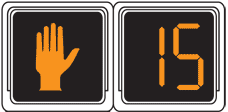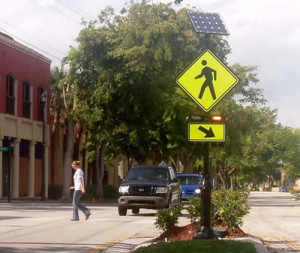At signalized intersections lacking pedestrian signals, crossing pedestrians are regulated by the vehicle traffic signals. Unfortunately, vehicle signals have a shorter clearance interval than pedestrians may need to finish crossing wide intersections. This can trap pedestrians in the middle of the intersection when the light turns red and conflicting movements begin. Some vehicular signals, such as green right turn arrows, create special conflicts for pedestrians at the crosswalk. When no vehicles are present, demand-actuated vehicle traffic signals may never change to allow a pedestrian to cross legally. Lastly, some mid-block locations are dangerous for pedestrians to cross without signal protection. Pedestrian signal heads and detectors were developed to address these problems. However, poor implementations and public confusion about ped signals can limit their effectiveness.
The Manual on Uniform Traffic Control Devices (MUTCD) defines the meanings for pedestrian signal head indications in the United States. These meanings appear below.
 A steady WALKING PERSON (symbolizing WALK) signal indication means that a pedestrian facing the signal indication is permitted to start to cross the roadway in the direction of the signal indication, possibly in conflict with turning vehicles.
A steady WALKING PERSON (symbolizing WALK) signal indication means that a pedestrian facing the signal indication is permitted to start to cross the roadway in the direction of the signal indication, possibly in conflict with turning vehicles.
The pedestrian shall yield the right-of-way to vehicles lawfully within the intersection at the time that the WALKING PERSON (symbolizing WALK) signal indication is first shown.
 A flashing UPRAISED HAND (symbolizing DONT WALK) signal indication means that a pedestrian shall not start to cross the roadway in the direction of the signal indication, but that any pedestrian who has already started to cross on a steady WALKING PERSON (symbolizing WALK) signal indication shall proceed to the far side of the traveled way of the street or highway, unless otherwise directed by a traffic control device to proceed only to the median of a divided highway or only to some other island or pedestrian refuge area.
A flashing UPRAISED HAND (symbolizing DONT WALK) signal indication means that a pedestrian shall not start to cross the roadway in the direction of the signal indication, but that any pedestrian who has already started to cross on a steady WALKING PERSON (symbolizing WALK) signal indication shall proceed to the far side of the traveled way of the street or highway, unless otherwise directed by a traffic control device to proceed only to the median of a divided highway or only to some other island or pedestrian refuge area.
 A steady UPRAISED HAND (symbolizing DONT WALK) signal indication means that a pedestrian shall not enter the roadway in the direction of the signal indication.
A steady UPRAISED HAND (symbolizing DONT WALK) signal indication means that a pedestrian shall not enter the roadway in the direction of the signal indication.
Pedestrian Signal Duration
The duration of the flashing upraised hand indication (also known as the pedestrian change interval) is based on the time a pedestrian will require to walk across the street at a speed of 3.5 feet per second. Many people misinterpret the meaning of the flashing upraised hand indication, believing that pedestrians are not allowed to be in the intersection during its display. As a result some motorists harass or endanger pedestrians during the flashing hand phase, and some pedestrians express alarm when the flashing hand starts early in their crossing. At especially wide intersections, most of the crossing time will be spent with the flashing hand indication. This can lead many pedestrians to start crossing during the flashing hand whether they have time to finish or not.
 To address these problems, the MUTCD now requires pedestrian countdown timers to be installed wherever the pedestrian change interval is over seven seconds long. This underscores the meaning of the flashing hand and informs pedestrians of exactly how much time they have to finish crossing. Studies have shown that countdown timers increase the percentage of pedestrians who complete crossing before steady upraised hand is displayed even though some faster pedestrians enter the crosswalk late.
To address these problems, the MUTCD now requires pedestrian countdown timers to be installed wherever the pedestrian change interval is over seven seconds long. This underscores the meaning of the flashing hand and informs pedestrians of exactly how much time they have to finish crossing. Studies have shown that countdown timers increase the percentage of pedestrians who complete crossing before steady upraised hand is displayed even though some faster pedestrians enter the crosswalk late.
The vehicle signal for traffic parallel to the pedestrian’s path will usually turn red after the end of the pedestrian change interval, but at some demand-actuated signals the green may be extended depending on the detected traffic pattern. A pedestrian signal that is programmed to persist the WALK plus pedestrian change interval to last the full duration of the vehicular green signal is referred to as operating in “rest in walk” mode. This is the preferred mode for pedestrians because it maximizes pedestrians’ opportunity to begin crossing the street. Conversely, a signal that is programmed to end the pedestrian change interval before the end of the vehicular green is undesirable for pedestrians, and is associated with lower pedestrian compliance rates. This mode is sometimes used in areas where pedestrian volumes are so high that traffic engineers want to stop the pedestrian flow in order to facilitate motorists’ turning movements.
Pedestrian Detectors
In the ideal case, pedestrians would receive a WALK signal without having to do anything. The signal would change on its own in a reasonable time and display the WALK signal. This is the case in many downtown areas, where traffic signals operate entirely on timers, and a WALK phase is included for each leg of the intersection on every signal cycle. In areas where signals are activated by the detection of traffic, things are more complicated. If no vehicles arrive at the intersection headed in the pedestrian’s direction, the signal will never change unless it detects the pedestrian waiting. This detection is most commonly done with a pushbutton. Passive pedestrian detection systems also exist, but are uncommon due to their expense.
Sometimes a detected vehicle will activate a green vehicle signal, but the corresponding WALK signal doesn’t appear. This is common where traffic engineers seek to optimize signals for drivers on wide intersections with infrequent pedestrian traffic. Including a seven second WALK light plus a long pedestrian change interval in every signal cycle could increase delay for motorists, so traffic engineers often program the signal to only include pedestrian phases if a pedestrian has been detected. As a result, pedestrians often encounter signal cycles lacking a pedestrian phase, because they did not see the pushbutton, did not realize the requirement to push it, or did not reach it in time. This is especially frustrating when pushbuttons are poorly located. A signal that is programmed to provide a pedestrian phase with every cycle is referred to as programmed for “pedestrian recall;” this mode is preferable for pedestrians and results in improved pedestrian compliance rates. Note that by keeping crossing distances short at intersections, such as through road diets or avoiding road widening, pedestrian change intervals can be kept short enough that traffic engineers will be more likely to program the signals for pedestrian recall.
Leading Pedestrian Interval
When a green vehicle signal phase and pedestrian WALK phase start at the same time, this can create a race between drivers and pedestrians to get to the corner first, where pedestrians can find themselves cut off by right turning drivers. A signal programmed with a leading pedestrian interval will illuminate the WALK signal a few seconds before the vehicle green. This gives waiting pedestrians a head start across the intersection and puts them in a location that is more conspicuous to turning drivers prior to the green light.
Accessible Pedestrian Signals
To accommodate visually impaired pedestrians, pedestrian signals may include audio cues such as recorded speech instructions or tones. These acoustic features of accessible pedestrian signals are still the subject of ongoing standards development and are not yet required at all pedestrian signal locations at the time of this writing, but the ADA Public Right-of-Way Accessibility Guidelines (PROWAG) are headed in that direction.
HAWK Beacons
 Another type of pedestrian signal, used at mid-block locations, is the HAWK beacon (High-Intensity Activated crossWalK beacon), officially called Pedestrian Hybrid Beacon. A HAWK beacon looks like any other pedestrian signal to the pedestrian facing the crosswalk, but the vehicle driver sees no signal illumination until a pedestrian wants to cross the road. When the HAWK beacon is activated, the vehicle signal displays a succession of flashing and steady yellow then red indications prior to beginning the pedestrian phase. The vehicle signal returns to a flashing red (equivalent of a stop sign) during the pedestrian changeover and goes dark at the end of the pedestrian phase. HAWK beacons can be useful for improving the safety of pedestrian crossings at locations where pedestrian volumes do not meet MUTCD warrants for conventional traffic signals.
Another type of pedestrian signal, used at mid-block locations, is the HAWK beacon (High-Intensity Activated crossWalK beacon), officially called Pedestrian Hybrid Beacon. A HAWK beacon looks like any other pedestrian signal to the pedestrian facing the crosswalk, but the vehicle driver sees no signal illumination until a pedestrian wants to cross the road. When the HAWK beacon is activated, the vehicle signal displays a succession of flashing and steady yellow then red indications prior to beginning the pedestrian phase. The vehicle signal returns to a flashing red (equivalent of a stop sign) during the pedestrian changeover and goes dark at the end of the pedestrian phase. HAWK beacons can be useful for improving the safety of pedestrian crossings at locations where pedestrian volumes do not meet MUTCD warrants for conventional traffic signals.
Rectangular Rapid Flash Beacons
 Another type of signal used to augment mid-block crosswalks is the Rectangular Rapid Flash Beacon, or RRFB. RRFBs are flashing yellow lights that alert drivers when a pedestrian is crossing at an uncontrolled crosswalk, i.e. where a normal traffic signal is not in operation. RRFBs do not regulate when pedestrians may cross, but increase the safety of their crossing. RRFBs are co-located with crosswalk signs, typically on both sides of the roadway and in the median. Activation of the beacons is accomplished by pedestrian pushbuttons or passive pedestrian sensors. Studies have shown that RRFBs increase motorist yielding rates, in one experiment from a baseline of 28% to an average of 93%.
Another type of signal used to augment mid-block crosswalks is the Rectangular Rapid Flash Beacon, or RRFB. RRFBs are flashing yellow lights that alert drivers when a pedestrian is crossing at an uncontrolled crosswalk, i.e. where a normal traffic signal is not in operation. RRFBs do not regulate when pedestrians may cross, but increase the safety of their crossing. RRFBs are co-located with crosswalk signs, typically on both sides of the roadway and in the median. Activation of the beacons is accomplished by pedestrian pushbuttons or passive pedestrian sensors. Studies have shown that RRFBs increase motorist yielding rates, in one experiment from a baseline of 28% to an average of 93%.